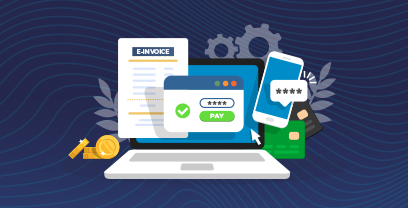Still struggling under the weight of paper or PDF invoices? If so, it’s costing you more than time, it’s impacting your working capital as well. Inefficient invoice processing drains resources, increases risk, and keeps your AP team stuck in the weeds.
The right invoice automation software can change that, bringing speed, accuracy, and cash control to even the most complex environments.
In this blog, we examine the common pain points Finance teams face around invoice processing, and the key features best invoice invoice automation software solutions offer, so you’ll know how to choose the right one.
Key Takeaways
- Paying the right Invoice, at the right time is the name of the game, AP should be focusing on automating the basics, not scanning or coding invoices.
- Manual processes are the root cause of most AP inefficiencies – and they often stem from poor data quality, disconnected systems, and lack of visibility.
- AP teams need solutions for 100% of their Invoice volume, not purely PO backed indirect invoices. This requires high-level of supplier self-service, together with Contract and/or Goods/Service Receipt matching.
- The most effective invoice automation tools offer features such as instant exception routing, real-time tracking, and tax compliance, all of which are critical for enterprise account payable teams.
Organizations that tailor workflows to their business instead of to the software see the highest ROI. Flexibility and configurability are key to driving adoption and delivering long-term value.
| Learn how Ivalua’s Invoice Software enables you to pay suppliers at the right time, every time, and give all stakeholders visibility into your spend cycle. Find Out More. |
Invoice Automation: Its Role in Procurement and Finance At a Glance
You’re here for the top solutions – but first, it helps to understand what the best invoice automation software actually solves.
Common AP such as manual data entry or coding, PO mismatches, non-PO workflows, siloed approvals, and supplier confusion create risk, delays, and inefficiency.
The table below outlines the process failures and operational risks that threaten procurement operations – and how an invoice automation solution can solve them.
| Problem | Operational Risk | Invoice Automation Solution |
| Process failure | Delays, duplicate payments, missed payments, compliance gaps | End-to-end digital workflows with real-time visibility |
| Manual data entry | Errors, duplicate payments, data integrity issues | AI/OCR + intelligent data capture and validation |
| Time-intensive, human error | Bottlenecks, inconsistent processing | Automated processing with fewer touchpoints |
| PO mis-match | Payment delays, overpayment, fraud exposure | 3-way matching and exception handling logic |
| Non-PO backed Invoice | Duplicate payment, overpayment, late payment | Contract and/or Receipt matching |
| Siloed approvals | Lack of accountability, stalled invoice cycles | Role-based, automated approval workflows |
| Exception handling | Lost invoices, unresolved issues, late payments, | Real time supplier collaboration in Portal |
| Supplier queries | Supplier dissatisfaction, time drain on AP team | Self-service supplier portal with real-time status |
| No audit trail | Failed audits, compliance violations | Full version history, tamper-proof process, and audit-ready documentation |
In the next section, we break down the core features to look for, what they do, and how they directly address common enterprise pain points. We’ll also take a look at how Ivalua applies these capabilities in realistic scenarios.
| Need help assessing your current process? Grab our AP checklist. |
6 Key Features of Automated Invoice Processing
Choosing invoice automation software is important for solving real problems that slow down your AP process and increase risk. Here are some key features to look for in a solution.
1) Pay the Right Invoice, at the Right Time
At the end of the process is the payment transaction. If the invoice receipt to OK-to-pay is inefficient, then each day wasted erodes your working capital opportunity. Likewise, the time between Ok-to-pay and transferring funds needs to be equally controlled and automated. Paying an invoice a day too early or when the supplier is a potential commercial or reputational risk is throwing away cash. Committing funds due to batch processing 7 or even 14 days, when open Banking allows you to pay the next day is hitting your bottom line.
Secure payment workflows can automatically flag risk, validate the supplier bank accounts, check for duplications, and can transfer funds the next day. By offering total control and visibility over each transfer, you can block fraud and unlock your working capital. Paying at the right time doesn’t mean paying early, it’s about paying at the best time for your cashflow.
2) PO and Contract Matching
Matching logic is essential for accurate invoice processing, because it ensures that what you’re paying for matches what was ordered and received. There are different levels of matching:
- 2-Way Matching compares the invoice to one reference point, this could be the purchase order (PO), a contract or the Goods/Services receipt to confirm items, quantities, prices, and terms align.
- 3-Way Matching adds a second reference point to the matching, typically a goods receipt for confirmation of services delivered, ensuring you only pay for what’s been received.
- 4-Way Matching adds an extra reference layer by including inspection results or quality checks, which is especially valuable in manufacturing, healthcare, or regulated industries.
Manual matching is slow and error-prone, but automation accelerates the process by instantly validating invoice data against POs, receipts, and contracts. It also flags mismatches or exceptions for quick review, and routs issues to the right approver based on pre-set rules. The result? Reduce processing time, prevents overpayments, and keeps audits clean.
Example in Practice: Flexible Multi-way Matching
Your procurement department receives an invoice for components that partially match the PO and receipt. As part of our Procure-to-Pay software, Ivalua’s electronic invoicing solution flags the quantity mismatch, applies predefined tolerances, and routes the exception to the sourcing lead. The issue can then be resolved quickly, without manual intervention.
3) No-code Invoice Approval Workflows
Manual approval chains often lead to missed deadlines and compliance risks. With no-code invoice approval workflows, teams can configure and adapt processes without IT support and still ensure that invoices can move quickly and securely through the right hands.
With no-code workflows, you can build role-based approval chains that route invoices automatically based on key conditions such as invoice amount, department, region, or even risk indicators. Whether you need CFO approval for high-value invoices or regional review for localized purchases, you can adapt the workflows to your business logic.
Example in Practice: Update Rules without Coding
Using a no-code/low-code procurement platform, you can easily update rules as your organization grows or policies change, without having to write code. This means faster processing, fewer exceptions, and clear accountability throughout the process.
4) Native ERP Integration and Multi-ERP Support
When invoice data is scattered across multiple ERPs or procurement systems, it slows down processing, increases errors, and leaves teams without sufficient spend analysis.
Native ERP integration solves this by enabling live data synchronization – invoice, PO, and payment data flow seamlessly between platforms. With multi-ERP support, organizations can centralize accounts payable operations, even if different regions or business units rely on different ERP systems.
This means no more toggling between platforms or manually reconciling records. You gain a single, unified view of invoices and approvals across the enterprise, for better control, faster processing, and improved compliance.
Example in Practice: Connect Any ERP
Ivalua’s multi-ERP integration capabilities make it easy to connect to any ERP environment. For example, a global manufacturer using SAP in Europe and Oracle in North America can manage all invoice approvals, validations, and reporting through Ivalua, without disrupting existing systems or workflows.
5) Supplier Collaboration and e-Invoicing Intake
Managing supplier invoices through email and spreadsheets creates friction, delays, and unnecessary work for AP teams. With integrated e-invoicing and supplier collaboration tools, suppliers can submit invoices directly, track their status in real time, and correct errors without relying on back-and-forth emails.
A self-service approach reduces administrative overhead while improving invoice accuracy. It also strengthens supplier relationships by increasing transparency and speeding up payments. Built-in validations at the point of submission help prevent duplicate invoices or missing PO numbers.
Example in Practice: User-friendly Portal
With supplier management software, suppliers gain access to a secure, user-friendly portal where they can view invoice history, respond to exceptions, and stay informed every step of the way.
6) Audit Trail, Exception Handling, and Controls
In enterprise Accounts Payable (AP), traceability and control are essential. With built-in audit trails and smart exception handling, every action, edit, and approval is automatically recorded. This creates a transparent, verifiable history for every invoice, which makes audits and compliance easier, while improving accountability.
Configurable thresholds and rules-based logic ensure invoices are flagged automatically for amount discrepancies, missing PO matches, duplicate entries or other issues. Then, they can be instantly routed to the right stakeholder, reducing delays and helping to ensure rapid resolution.
Example in Practice: Enforcing Business Rules
Ivalua’s contract lifecycle management solution help teams enforce business rules, reduce manual oversight, and build a defensible AP process that scales. Whether it’s routing a high-value invoice for executive review or flagging a compliance risk, every exception is handled with speed and clarity.
7) Analytics and Performance KPIs
To optimize AP performance, visibility into what’s working and what isn’t is critical. Built-in analytics and real-time dashboards can help you track key metrics such as invoice cycle time, touchless processing rate, exception rate, early payment capture, or discounts.
These insights help teams identify any bottlenecks and improve supplier relationships, while revealing savings opportunities.
Example in Practice: Assess AP Performance
Ivalua’s advanced spend and performance analytics provides organizations with a centralized view of AP performance across business units and regions. With this information, continuous improvement and strategic impact is possible from day one.
| Download the Invoice Hub datasheet to see how Ivalua streamlines invoice intake, boosts visibility, and puts you in full control of your AP process. |
How to Implement Invoice Automation Across Fragmented Systems: 4 Steps
Automating invoices across fragmented systems and departments is challenging, but it’s entirely achievable with the right approach. These four steps will help you implement procure-to-pay best practices and align systems, teams, and suppliers to drive results.
Step 1: Consolidate and Standardize Supplier Data
Automation only works if the data behind it is clean and consistent. For most organizations, that starts with supplier records. Duplicate or mismatched vendor entries across ERPs and e-procurement software can break workflows, delay payments, and trigger exceptions that should never happen.
The key is to unify supplier data into a single, trusted source. With Ivalua’s supplier management software, you can create a centralized supplier master, enriched with validations and data governance rules that prevent duplicates and errors from the start. Fixing the foundation up-front sets the stage for reliable, scalable automation later.
Step 2: Introduce Supplier Intake and Seamless Self-Service
A seamless supplier experience will drive automation. Forgetting to embrace your suppliers is the biggest mistake you can make. Suppliers want to get paid, and this drives behavior. Turn each invoice inquiry into a self-service journey, allow suppliers to correct data errors to enable touchless processing, provide real-time collaboration to unblock exceptions, and give them total visibility of each step to payment.
Each Ivalua client has a unique branded Business Network, allowing instant collaboration and interaction. You can share data, validate documents, run surveys, and guide partners to add missing master data, or respond to a tender.
This is how we get 98% supplier adoption for our clients within months, without a heavy onboarding team. Ivalua don’t have a shared supplier network, because they don’t work for our clients, they are not Ivalua suppliers, they are your business partners.
Step 3: Configure Approval Rules and Matching Tolerances
Getting invoice automation right means more than just defining who needs to approve what. You also have to set clear rules for when something shouldn’t go through automatically. Does a small price variance trigger a manual review? What about a missing PO or a suspicious supplier?
With Ivalua’s no-code/low-code procurement platform, you can configure approval chains and matching tolerances to reflect your actual business policies instead of using generic templates. Having that flexibility matters, because when source-to-pay tools force you to adapt your processes to fit their structure, you lose efficiency and increase risk.
Ivalua flips that model, letting your teams build rules that work the way you do. This enables faster approvals and reduces errors, while making it easier to scale automation.
Step 4: Integrate Invoice Workflows with ERP and Procurement Systems
One of the biggest blockers to smooth invoice automation is when systems are disconnected. For example, POs may live in one platform, receipts in another, and invoice approvals somewhere else entirely. This fragmentation creates delays and a lot of manual work.
By syncing data between your PO, GRN, contract, and invoice solutions, everything flows through one streamlined process. With Ivalua’s multi-ERP integration capabilities, you can connect directly to multiple ERP and procurement software, keeping data aligned and approvals moving within a single, unified workflow.
Step 5: Build and Test Exception Scenarios Early
Even the best automation can break if you don’t plan for the edge cases – things like invoices without POs, line-level mismatches, or noncompliant suppliers. While these issues aren’t rare, if they can derail your entire process.
That’s why it’s critical to define exception handling rules early in your implementation of any invoice-to-pay solution. With Ivalua’s configurable invoice-to-pay workflows, you can set custom tolerances, automate routing to the right stakeholders, and resolve exceptions quickly, without having to create workarounds.
| Check out Demo Days On Demand to explore how Ivalua streamlines payments, reduces risk, and accelerates AP performance. |
Customer Story: Maxim Onboards Over 1,100 Suppliers in 8 weeks
Maxim Healthcare, a leading national provider of healthcare services, struggled with a legacy procure-to-pay (P2P) system that delivered low supplier adoption, poor usability, and minimal return on investment. After seven years, only 15 suppliers had been onboarded, and 80% of invoices were still processed manually.
The system’s complexity led to increased paper invoices, time-consuming processes, and frustration among users. Additionally, supplier fees discouraged participation, and rigid catalog and invoicing tools limited purchasing on contract.
Maxim selected Ivalua to replace its underperforming P2P system. In just eight weeks, they enabled over 1,118 users, made 2,162 catalog items available, and launched 10 hosted supplier catalogs. Importantly, they onboarded more suppliers in those first eight weeks than in the previous seven years.
“We have more control and flexibility than we had before. We were able to make our own updates without support or additional services.”
– Cindy Seabrease Director of Purchasing and Accounts Payable Maxim Healthcare
Read the full Maxim Healthcare case study.
Scale Your AP Process with Confidence
Invoice automation saves you time and gets suppliers paid faster – but it’s not only about speed. You also gain visibility and control, reduce risk, improve compliance, and strengthen supplier relationships.
The right accounts payable automation solution can help your accounts payable team – and procurement as a whole – be a strategic business partner rather than back-office function and cost center.
If you’re dealing with fragmented systems, manual processes, or limited visibility, now’s the time to rethink your approach. Explore how Ivalua’s e-invoicing solution helps global organizations streamline invoice processing, unify data across ERPs, and achieve faster, more accurate payments at scale.
| See how leading companies automate AP for speed, control, and savings with Ivalua. Watch Demo | Find Out More |
FAQs About Automated Invoice Processing
How does invoice automation reduce errors and exceptions?
Invoice automation eliminates manual data entry by using OCR, validation rules, and matching logic to catch discrepancies upfront. This reduces duplicate payments, mismatched POs, and other common errors, without needing manual intervention.
How does invoice automation improve cycle time and visibility?
By automating invoice intake, routing, and approvals, cycle times are significantly reduced. At the same time, real-time dashboards and audit trails give stakeholders full visibility into invoice status, along with any potential bottlenecks.
Can automated invoice processing work across multiple ERPs?
Yes. Leading solutions like Ivalua offer native integrations and multi-ERP support, allowing invoice data to sync seamlessly across different systems. This ensures consistency, central visibility, and process efficiency, no matter how complex your IT landscape.




